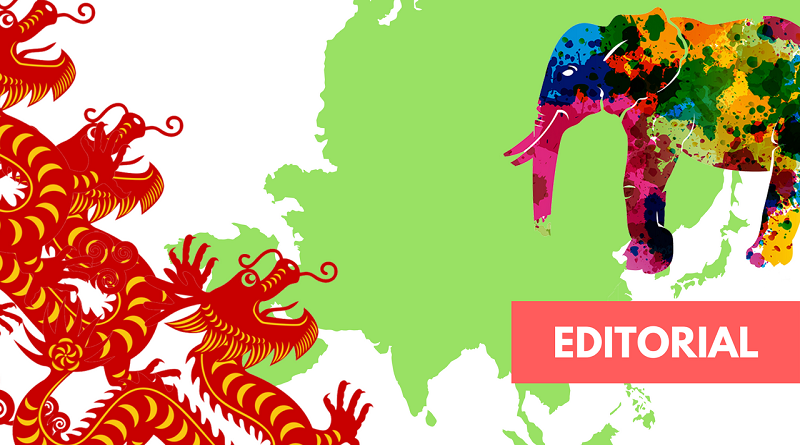The Asian Century: The Elephant’s Perspective Towards The Dragon

India and China have quadrupled their share of the global economy proving that not only they are the largest goods producer but also the largest consumers in this global village. Apparently with the target of producing half of the world global output, the Asian region is swiftly attracting the investors and the business leader towards the Asia. – Amrita Dhillon*
When the Indian Prime Minister Modi’s referring to the 21st century as the Asian Century, the role of India was promoted to the far east and west, overlapping the North-South gap as well as advocating promisingly the Golden Asian days of silk route which accounted the 60% of the world GDP share till the days of the Industrial Revolution in Europe and European colonization of Asia.
Today this is an undeniable fact that Asia is rising, the ship of the world economy is sailing from the west to the east. The Indo-pacific region has risen as an immense and enduring importance to the global Economic stability and prosperity at the individual level. If we look at the today’s Geo-economic world then we will find the 3 of the 5 largest economies in the world apparently in Asia- China, India & Japan.
In the last two decades, India and China have quadrupled their share of the global economy proving that not only they are the largest goods producer but also the largest consumers in this global village. Apparently, with the target of producing half of the world global output, the Asian region is swiftly attracting the investors and the business leader towards the Asia.
However, today as it appears as a divided continent and far from being a cohesive unit due to its diverse and huge population, who are sharing different historical and cultural values unlike the two Americas, Africa and the Europe. Even the leading thinkers found it easier to explain the region using the fragmentations for the entire continent, as the Middle-East, Central & South Asia or the Pacific, due to the lack of cohesiveness among the Asians it is often seen as the Gordian Knot that needs to be unknotted before claiming themselves the patrons of the Asian Century.
Accounting 20% of the world land area, home to the half of the world population, the all 49 economies under different political system and philosophy could be seen as one of the critical thought which could stop the Asian chariot to reach the half of the global output which is currently 27%.
Before claiming the century for the change, Asians must look closely into the economies which matter and have influenced the western leaders like Hillary Clinton to proclaim the era as the century of Pacific, in clearer words which define the American dream to sail to the Pacific instead of Atlantic for trade. The Asian 7 economies, which helped Asia, re-emerged on the contemporary Geo-Political and Geo-economic world map – PRC, India, Indonesia, Japan, South Korea, Malaysia & Thailand are holding the chariot for the rising high-end life in the East.

Are India & China the Pivots in minimising the western influence in the opportunistic Asian market?
Before the colonisation, India and China shared strong cultural bonds and accounted 50% of the world GDP, the vast maritime trade empire attracted the traders from the west and after the colonisation, the global GDP share for the two Asian neighbours rolled down to less than 10%.
AIIB – The Asian Infrastructure Bank is all set to help Asia re-acquiring its potential and also to minimise the western influence in the Asian Markets. India and China being the largest contributor to this institutions secure around one third of its total investment making it ready to promote a cohesive and accountable cooperation for the Asian economies, with more opportunities and special focus on the not well off states of the East, which could further help Asians achieve their vision to promote their per capita in six folds in simple words which means no poor countries in Asia by 2050, as discussed in a draft report by Asian Development Bank – Asia 2050 — Realizing the Asian Century.
Challenges to shatter a billion dreams
Europeans are frequently blamed for distorting the Asian history and manipulation the Asian growth stories, however, the historical facts provided by the EU think tanks on the Asian Economy trend seems to elucidate the true version by presenting the Asian development graph showing the development as not linear but curved in nature for its long-term growth maintenance.
As the century has just begun so the Asian opportunities, which give rise to the challenges as the rising inequities among states, Middle-income trap, the disparities between the states, rising face of the climate which instigates the rise of sea levels for the countries like Vietnam, Bangladesh and Maldives, and above all the lack of spirit among the governments to adopt a proactive collateral growth by the means of the multifaceted, multicultural agenda and close cooperation on the regional level.
The rising tensions between the two Asian giants, India & China are doing collateral damage to the dreams of the Asian century which could lead the region in the less cooperative fiasco and stumbling Asians towards the Middle Income Trap, if we believe the report by the Asian Development Bank is could reduce the corresponding figures of cumulative GDP at $61 trillion, a per capita of $20,300 and accounts 32 percent of the global output respectively. Which is believed to be having a cumulative GDP of $148 trillion, a per capita GDP of $38,500 (in purchasing power parity) and account for 51 percent of global output?
Moreover, the challenges as the urban population growth rate could possess a grave threat to the Asian States which is believed to be doubled by the year 2050- the year of Asian Dream.

*Amrita Dhillon is the Founding Editor of The Kootneeti. Her area of interest includes the Asiatic trade & policies


















